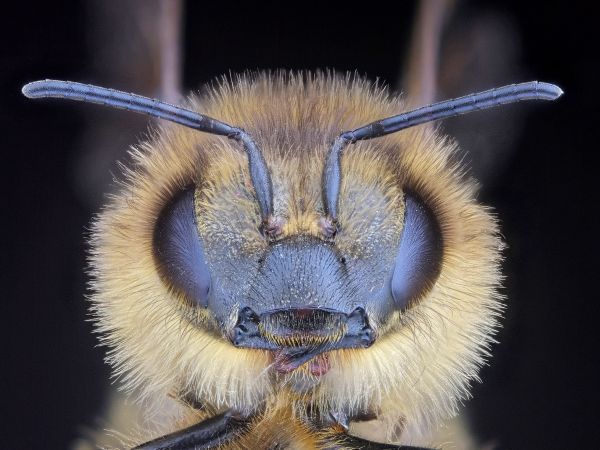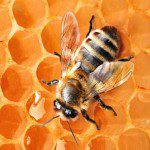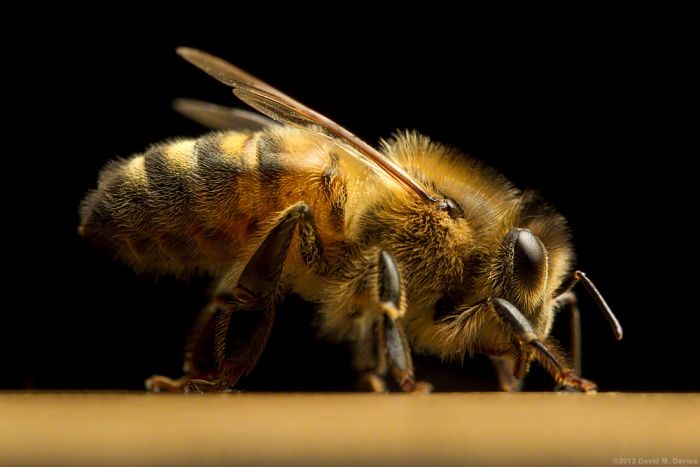Yes, a honey bee can see, smell, taste, touch and … not speak like we do. They dance. But all the other senses are very well developed, and here are some words about them:
Can honey bees see like we do?
Not quite. Honey bees cannot see the red color. But they see UV!
Although honey bees perceive a fairly broad color range, they do not perceive them like humans do.
They can see: yellow, blue-green, blue, violet, ultraviolet, and also a color known as “bee’s purple,” a mixture of yellow and ultraviolet, but not red. (instead of red they see other reddish wavelengths such as orange and yellow) Differentiation is not equally good throughout the range and is best in the blue-green, violet, and bee’s purple colors.

!Honey bees are attracted and become aggressive to some colors, which are not the colors of the flowers, but those of their enemies. Bold, darker colors like red and black resemble natural predators and they may trouble the bees enough to become aggressive towards people. If they decide to attack you, they will be doing it in contrast areas like collars and cuffs. Those are the areas that resemble weak spots like the eyes and nose of predators.
!White is the best color to wear (remember the beekeepers’ suits) or other lighter colors. The clothes should also have a smooth texture, as the thick, fuzzy ones remember the fur of predators like skunks and badgers.
!There are some detergents that contain UV brighteners. Using them we may attract bees not matter what color our clothes are.
Can they smell like we do?

Different.
Honey bees have 170 odorant receptors. In a world of insects this is very much, if we consider, for example, fruit flies, which have only 62 or mosquitoes, which have 79.
They have exceptional olfactory abilities, with a sense of smell that is so precise that can differentiate between hundreds of different flowers and can tell if a flower carries nectar from meters away.
Honey bees also use pheromones to communicate, to guard, to locate, to mate and so on. Here are some examples:
– guard bees identify the bees.
Each colony has a specific odor and this allows the bees to identify their kin. There are special guard bees that stay at the entrance of the hive. They can smell all the bees trying to enter. If one of them does not belong to that colony is immediately expelled.
– the queen attracts males with sex pheromone.
When it is still virgin, the queen produces a special odor, that people named it ‘sex Pheromone” to attract males (drones) for the mating flight .
– bees use odors to locate their hive, or their new home after swarming.
From our point of view, this pheromone smells lemony. Besides this sex pheromone, the queen controls of the colony by a pheromone known as the “queen substance.”
As long as it is being passed around in the hive, the message in the colony is that “we have a queen and all is well.” When a beekeeper wants to change the queen from a colony with one from a different hive, he should place the queen in a cage within the colony for up to five days in order for the worker bees to get used to its odor.
– warning pheromone.
When a bee stings, it releases an odor called an alarm pheromone that will alert the other bees of the danger and will call them to defend the hive. We sense this pheromone as the smell of bananas. It’s an incredibly persisting smell, it won’t come out of your clothes, so if you are stung you should wash your clothing before wearing them again. Otherwise the smell will call other bees, which will repeat the story.
 !There are certain smells that honey bees don’t like, and will turn them aggressive to the point of stinging and losing their lives. When going to a picnic or anywhere where bees can be, remember to not be surrounded by odors of: onion, garlic, alcoholic drinks, sweat, as well as really strong scents of perfume, body lotions or laundry detergent.
!There are certain smells that honey bees don’t like, and will turn them aggressive to the point of stinging and losing their lives. When going to a picnic or anywhere where bees can be, remember to not be surrounded by odors of: onion, garlic, alcoholic drinks, sweat, as well as really strong scents of perfume, body lotions or laundry detergent.
The amazing smell of bees is nowadays used by the scientists to detect and track down explosives hidden by terrorists. The prototype under trial is made up of a box device containing three trained bees built into a removable drawer. A video camera records the bees’ response, which can trigger off a signal upon even the faintest trace of explosives. It is said that the bees are able to “detect the scent of explosives at concentrations as low as two parts per trillion, which is the equivalent of finding a grain of sand in a swimming pool”.
Compared to dogs, bees don’t get distracted from their task easily, learn quicker, and are cheaper to maintain. Watch this video to really be amazed of how amazing the working bees are. Here is the action team of Los Alamos National Laboratory Stealthy Insect Sensor Project team :
Can bees taste like we do?
Almost the same.
They can differentiate between sweet, salty, sour and bitter, just like we humans do. The differences are that bees are more sensitive to salts than humans, but less sensitive to bitter. Also, because of our processed and “improved” food, humans have the “umami” taste. You can find out more about this recently discovered taste, here.
Can they touch like we do?
Better.
They can feel vibrations in the air much better than we can. Honey bees can feel the direction of he wind flow, can tell if there’s about to rain, or if nearby is a chainsaw ready to cut down their tree.
The bees use their antennae to gauge the width and depth of cells while constructing combs. They also communicate via touch during their dances.
Can they speak like we do?
No. But they do communicate between odors and dancing. They are great dancers!
When a honey bee discover a food source it returns to the hive to tell the other about location and nectar’s quality. This is done through dancing. It is called the WAGGLE DANCE. The honey bee shakes its body and dances a certain period of time, thus communicating the others the precise direction, the shortest way, the quantity and quality of nectar But they do communicate between odors and dancing. They are great dancers!
When a honey bee discover a food source it returns to the hive to tell the other about location and nectar’s quality. This is done through dancing. It shakes its body and dances a certain time, thus communicating the others the precise direction, the shortest way, the quantity and quality of nectar.

Related articles:
• Do honey bees communicate?
• The jobs of a bee. What is the life of a bee?
• The honey bee QUEEN
• Japanese Honeybees vs Giant Hornet
• How to treat bee sting
Info references:
http://www.orkin.com/stinging-pests/bees;
http://www.benefits-of-honey.com
http://sonomabees.org/index.html
http://www.quora.com

hi, I’m doing a research task of bees and other animals and found your website and found it so useful, so i was wondering for my bibliography referencing when this article was published? 🙂
Hi Sabine,
It was published on 19 May 2014.
I had no idea there was no info regarding author and date on pages. Only on posts. 🙁
Laura
Wow, that video is an eye opener. And I thought you can only train dogs to detect explosive. I look forward to see more of what bees can do to benefit humanity.
Interesting article. Good to know about what smells to avoid to help not get stung. Bees are always around when the kids and I are playing out back, must be the sunscreen and sweat!!
I have also added in the article what colors we should avoid. Thank you for dropping by.
laura
Hi Laura,
I never know of honey bee has all that instincts. i love your site, the pictures so clear and beside, your article is spot on. Well done!
VO
Thank you for your kind words. I’m trying to do the best.
laura